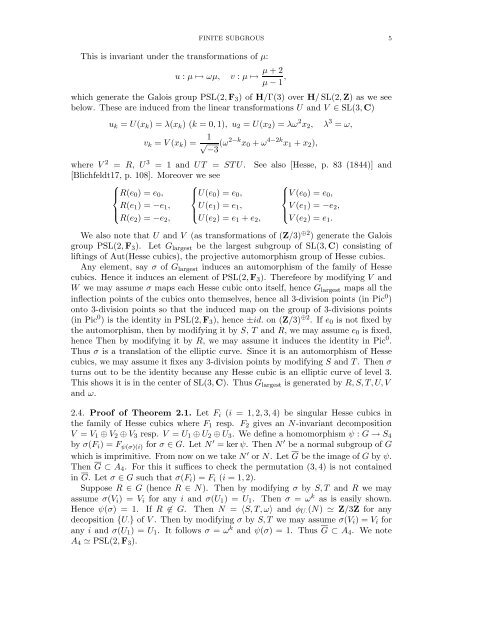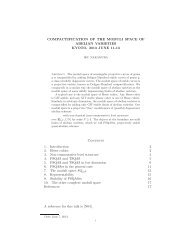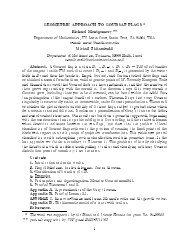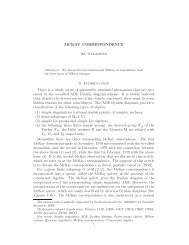A SHORT CLASSIFICATION OF FINITE SUBGROUPS OF SL(3,C) 0 ...
A SHORT CLASSIFICATION OF FINITE SUBGROUPS OF SL(3,C) 0 ...
A SHORT CLASSIFICATION OF FINITE SUBGROUPS OF SL(3,C) 0 ...
- No tags were found...
Create successful ePaper yourself
Turn your PDF publications into a flip-book with our unique Google optimized e-Paper software.
<strong>FINITE</strong> SUBGROUS 5This is invariant under the transformations of µ:u : µ ↦→ ωµ, v : µ ↦→ µ +2µ − 1 ,which generate the Galois group P<strong>SL</strong>(2, F 3 )ofH/Γ(3) over H/ <strong>SL</strong>(2, Z) as we seebelow. These are induced from the linear transformations U and V ∈ <strong>SL</strong>(3, C)u k = U(x k )=λ(x k )(k =0, 1), u 2 = U(x 2 )=λω 2 x 2 , λ 3 = ω,v k = V (x k )= 1 √ −3(ω 2−k x 0 + ω 4−2k x 1 + x 2 ),where V 2 = R, U 3 = 1 and UT = STU. See also [Hesse, p. 83 (1844)] and[Blichfeldt17, p. 108]. Moreover we see⎧⎧⎧⎪⎨ R(e 0 )=e 0 , ⎪⎨ U(e 0 )=e 0 , ⎪⎨ V (e 0 )=e 0 ,R(e 1 )=−e 1 , U(e 1 )=e 1 ,V (e 1 )=−e 2 ,⎪⎩⎪⎩⎪⎩R(e 2 )=−e 2 , U(e 2 )=e 1 + e 2 , V (e 2 )=e 1 .We also note that U and V (as transformations of (Z/3) ⊕2 ) generate the Galoisgroup P<strong>SL</strong>(2, F 3 ). Let G largest be the largest subgroup of <strong>SL</strong>(3, C) consisting ofliftings of Aut(Hesse cubics), the projective automorphism group of Hesse cubics.Any element, say σ of G largest induces an automorphism of the family of Hessecubics. Hence it induces an element of P<strong>SL</strong>(2, F 3 ). Therefeore by modifying V andW we may assume σ maps each Hesse cubic onto itself, hence G largest maps all theinflection points of the cubics onto themselves, hence all 3-division points (in Pic 0 )onto 3-division points so that the induced map on the group of 3-divisions points(in Pic 0 ) is the identity in P<strong>SL</strong>(2, F 3 ), hence ±id. on (Z/3) ⊕2 .Ife 0 is not fixed bythe automorphism, then by modifying it by S, T and R, we may assume e 0 is fixed,hence Then by modifying it by R, we may assume it induces the identity in Pic 0 .Thus σ is a translation of the elliptic curve. Since it is an automorphism of Hessecubics, we may assume it fixes any 3-division points by modifying S and T . Then σturns out to be the identity because any Hesse cubic is an elliptic curve of level 3.This shows it is in the center of <strong>SL</strong>(3, C). Thus G largest is generated by R, S, T, U, Vand ω.2.4. Proof of Theorem 2.1. Let F i (i =1, 2, 3, 4) be singular Hesse cubics inthe family of Hesse cubics where F 1 resp. F 2 gives an N-invariant decompositionV = V 1 ⊕ V 2 ⊕ V 3 resp. V = U 1 ⊕ U 2 ⊕ U 3 . We define a homomorphism ψ : G → S 4by σ(F i )=F ψ(σ)(i) for σ ∈ G. Let N ′ =kerψ. Then N ′ be a normal subgroup of Gwhich is imprimitive. From now on we take N ′ or N. Let G be the image of G by ψ.Then G ⊂ A 4 . For this it suffices to check the permutation (3, 4) is not containedin G. Let σ ∈ G such that σ(F i )=F i (i =1, 2).Suppose R ∈ G (hence R ∈ N). Then by modifying σ by S, T and R we mayassume σ(V i )=V i for any i and σ(U 1 )=U 1 . Then σ = ω k as is easily shown.Hence ψ(σ) = 1. If R ∉ G. Then N = 〈S, T, ω〉 and φ U·(N) ≃ Z/3Z for anydecopsition {U·} of V . Then by modifying σ by S, T we may assume σ(V i )=V i forany i and σ(U 1 )=U 1 . It follows σ = ω k and ψ(σ) = 1. Thus G ⊂ A 4 . We noteA 4 ≃ P<strong>SL</strong>(2, F 3 ).





